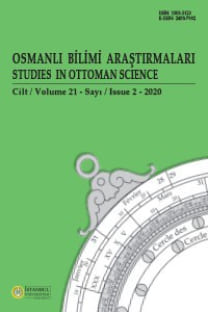Düzeltme / Corrigenda
The author, Nil Palabıyık-Pektaş, requested the following corrections toher article entitled ‘The beginnings of Printing in the Ottoman Capital’published in vol. XVI, issue 2, pp. 3-32 of the Studies in Ottoman Science..p. 4, note 6: Add reference: J.R. Osborn, 'The Type of Calligraphy:Writing, Print, and Technologies of the Arabic Alphabet', PhD thesis,University of California, San Diego, 2008, p. 153."p. 5: Replace: The first Quran was also printed with Arabic typeface inFano in 1537 or 1538 by the Venetian printer Alessandro Paganino (fl. 1509–1538). WITH: The first Quran was also printed with Arabic typeface in 1537 or1538 by the Venetian printer Alessandro Paganino (fl. 1509–1538).p. 5: Add quotation marks: The Islamic world 'cultivated a robustcalligraphic tradition', and 'calligraphy persisted as a celebrated art' with everevolving techniques and sophisticated abstract motifs even after the arrival ofprint. Add citation: J.R. Osborn, 'The Type of Calligraphy', p. 105.p. 5: Delete: (e.g. dal for dhal and ayn for ghayn, both of which aredistinguished from the former with a dot (nokta) placed above the stem).
Anahtar Kelimeler:
corrigenda, Düzeltme, Printing
Düzeltme / Corrigenda
The author, Nil Palabıyık-Pektaş, requested the following corrections toher article entitled ‘The beginnings of Printing in the Ottoman Capital’published in vol. XVI, issue 2, pp. 3-32 of the Studies in Ottoman Science..p. 4, note 6: Add reference: J.R. Osborn, 'The Type of Calligraphy:Writing, Print, and Technologies of the Arabic Alphabet', PhD thesis,University of California, San Diego, 2008, p. 153."p. 5: Replace: The first Quran was also printed with Arabic typeface inFano in 1537 or 1538 by the Venetian printer Alessandro Paganino (fl. 1509–1538). WITH: The first Quran was also printed with Arabic typeface in 1537 or1538 by the Venetian printer Alessandro Paganino (fl. 1509–1538).p. 5: Add quotation marks: The Islamic world 'cultivated a robustcalligraphic tradition', and 'calligraphy persisted as a celebrated art' with everevolving techniques and sophisticated abstract motifs even after the arrival ofprint. Add citation: J.R. Osborn, 'The Type of Calligraphy', p. 105.p. 5: Delete: (e.g. dal for dhal and ayn for ghayn, both of which aredistinguished from the former with a dot (nokta) placed above the stem).
Keywords:
Corrigenda, author, requested,
___
- -
- ISSN: 1303-3123
- Yayın Aralığı: Yılda 2 Sayı
- Başlangıç: 1995
- Yayıncı: İstanbul Üniversitesi Edebiyat Fakültesi
Sayıdaki Diğer Makaleler
Osmanlı’da sivil mühendis yetiştirmek üzere açılan Hendese-i Mülkiye Mektebi
Şinasi ACAR, Atilla BİR, Mustafa KAÇAR
Dr. jur. et phil. Erich Auerbach’ın İstanbul Üniversitesi ile sözleşmeleri
Dârüşşafaka dergisinin bilim, düşünce ve eğitim hayatımıza katkıları
